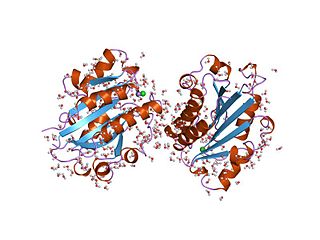Related Research Articles

von Willebrand factor (VWF) is a blood glycoprotein involved in hemostasis. It is deficient and/or defective in von Willebrand disease and is involved in many other diseases, including thrombotic thrombocytopenic purpura, Heyde's syndrome, and possibly hemolytic–uremic syndrome. Increased plasma levels in many cardiovascular, neoplastic, and connective tissue diseases are presumed to arise from adverse changes to the endothelium, and may predict an increased risk of thrombosis.

Laminins are high-molecular weight proteins of the extracellular matrix. They are a major component of the basal lamina, a protein network foundation for most cells and organs. The laminins are an important and biologically active part of the basal lamina, influencing cell differentiation, migration, and adhesion.

CTGF, also known as CCN2 or connective tissue growth factor, is a matricellular protein of the CCN family of extracellular matrix-associated heparin-binding proteins. CTGF has important roles in many biological processes, including cell adhesion, migration, proliferation, angiogenesis, skeletal development, and tissue wound repair, and is critically involved in fibrotic disease and several forms of cancers.

Collagen alpha-1(V) chain is a protein that in humans is encoded by the COL5A1 gene.

Cysteine-rich angiogenic inducer 61 (CYR61) or CCN family member 1 (CCN1), is a matricellular protein that in humans is encoded by the CYR61 gene.
Platelet membrane glycoproteins are surface glycoproteins found on platelets (thrombocytes) which play a key role in hemostasis. When the blood vessel wall is damaged, platelet membrane glycoproteins interact with the extracellular matrix.

The EGF-like domain is an evolutionary conserved protein domain, which derives its name from the epidermal growth factor where it was first described. It comprises about 30 to 40 amino-acid residues and has been found in a large number of mostly animal proteins. Most occurrences of the EGF-like domain are found in the extracellular domain of membrane-bound proteins or in proteins known to be secreted. An exception to this is the prostaglandin-endoperoxide synthase. The EGF-like domain includes 6 cysteine residues which in the epidermal growth factor have been shown to form 3 disulfide bonds. The structures of 4-disulfide EGF-domains have been solved from the laminin and integrin proteins. The main structure of EGF-like domains is a two-stranded β-sheet followed by a loop to a short C-terminal, two-stranded β-sheet. These two β-sheets are usually denoted as the major (N-terminal) and minor (C-terminal) sheets. EGF-like domains frequently occur in numerous tandem copies in proteins: these repeats typically fold together to form a single, linear solenoid domain block as a functional unit.

Collagen alpha-1(VI) chain is a protein that in humans is encoded by the COL6A1 gene.

Collagen alpha-2(VI) chain is a protein that in humans is encoded by the COL6A2 gene.

Collagen alpha-3(VI) chain is a protein that in humans is encoded by the COL6A3 gene. This protein is an alpha chain of type VI collagen that aids in microfibril formation. As part of type VI collagen, this protein has been implicated in Bethlem myopathy, Ullrich congenital muscular dystrophy (UCMD), and other diseases related to muscle and connective tissue.

WNT1-inducible-signaling pathway protein 1 (WISP-1), also known as CCN4, is a matricellular protein that in humans is encoded by the WISP1 gene.

WNT1-inducible-signaling pathway protein 3 is a matricellular protein that in humans is encoded by the WISP3 gene.

WNT1-inducible-signaling pathway protein 2, or WISP-2 is a matricellular protein that in humans is encoded by the WISP2 gene.

Collagen alpha-1(XVI) chain is a protein that in humans is encoded by the COL16A1 gene.

Matrilin 1, cartilage matrix protein, also known as MATN1, is a matrilin protein which in humans is encoded by the MATN1 gene.

von Willebrand factor A domain-containing protein 2, also known as A domain-containing protein similar to matrilin and collagen (AMACO) is a protein that in humans is encoded by the VWA2 gene.

Collagen alpha-5(VI) chain also known as von Willebrand factor A domain-containing protein 4 is a protein that in humans is encoded by the COL6A5 gene.

The von Willebrand factor type A (vWA) domain is a protein domain named after its occurrence in von Willebrand factor (vWF), a large multimeric glycoprotein found in blood plasma. Mutant forms of vWF are involved in the aetiology of bleeding disorders. This type A domain is the prototype for a protein superfamily.
CCN proteins are a family of extracellular matrix (ECM)-associated proteins involved in intercellular signaling. Due to their dynamic role within the ECM they are considered matricellular proteins.
Von Willebrand factor type D domain (vWD) is an evolutionarilly-conserved protein domain found in, among others, the von Willebrand factor (vWF). vWF is a large multimeric glycoprotein and it is synthesized by a type of bone marrow cell called megakaryocytes. The vWD domain allows vWF to perform its blood-clotting function by carrying factor VIII around.
References
- 1 2 Colombatti A, Bonaldo P, Doliana R (1993). "Type A modules: interacting domains found in several non-fibrillar collagens and in other extracellular matrix proteins". Matrix. 13 (4): 297–306. doi:10.1016/S0934-8832(11)80025-9. PMID 8412987.
- 1 2 Smith KF, Haris PI, Chapman D, Perkins SJ, Williams SC, Sim RB (1994). "The secondary structure of the von Willebrand factor type A domain in factor B of human complement by Fourier transform infrared spectroscopy. Its occurrence in collagen types VI, VII, XII and XIV, the integrins and other proteins by averaged structure predictions". J. Mol. Biol. 238 (1): 104–119. doi:10.1006/jmbi.1994.1271. PMID 8145250.
- 1 2 Bork P (1991). "Shuffled domains in extracellular proteins". FEBS Lett. 286 (1): 47–54. doi:10.1016/0014-5793(91)80937-X. PMID 1864378. S2CID 22126481.
- ↑ Hunt LT, Barker WC (1987). "von Willebrand factor shares a distinctive cysteine-rich domain with thrombospondin and procollagen". Biochem. Biophys. Res. Commun. 144 (2): 876–882. doi:10.1016/S0006-291X(87)80046-3. PMID 3495268.
- ↑ Voorberg J, Fontijn R, Calafat J, Janssen H, van Mourik JA, Pannekoek H (1991). "Assembly and routing of von Willebrand factor variants: the requirements for disulfide-linked dimerization reside within the carboxy-terminal 151 amino acids". J. Cell Biol. 113 (1): 195–205. doi:10.1083/jcb.113.1.195. PMC 2288914 . PMID 2007623.